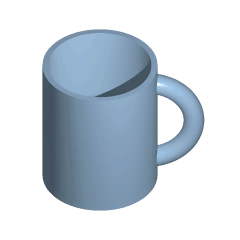
In
topology
Topology (from the Greek language, Greek words , and ) is the branch of mathematics concerned with the properties of a Mathematical object, geometric object that are preserved under Continuous function, continuous Deformation theory, deformat ...
, two
continuous function
In mathematics, a continuous function is a function such that a small variation of the argument induces a small variation of the value of the function. This implies there are no abrupt changes in value, known as '' discontinuities''. More preci ...
s from one
topological space
In mathematics, a topological space is, roughly speaking, a Geometry, geometrical space in which Closeness (mathematics), closeness is defined but cannot necessarily be measured by a numeric Distance (mathematics), distance. More specifically, a to ...
to another are called homotopic (from and ) if one can be "continuously deformed" into the other, such a deformation being called a homotopy ( ; ) between the two functions. A notable use of homotopy is the definition of
homotopy groups
In mathematics, homotopy groups are used in algebraic topology to classify topological spaces. The first and simplest homotopy group is the fundamental group, denoted \pi_1(X), which records information about Loop (topology), loops in a Mathematic ...
and
cohomotopy groups, important
invariants in
algebraic topology
Algebraic topology is a branch of mathematics that uses tools from abstract algebra to study topological spaces. The basic goal is to find algebraic invariant (mathematics), invariants that classification theorem, classify topological spaces up t ...
.
In practice, there are technical difficulties in using homotopies with certain spaces. Algebraic topologists work with
compactly generated spaces,
CW complex
In mathematics, and specifically in topology, a CW complex (also cellular complex or cell complex) is a topological space that is built by gluing together topological balls (so-called ''cells'') of different dimensions in specific ways. It generali ...
es, or
spectra.
Formal definition

Formally, a homotopy between two
continuous function
In mathematics, a continuous function is a function such that a small variation of the argument induces a small variation of the value of the function. This implies there are no abrupt changes in value, known as '' discontinuities''. More preci ...
s ''f'' and ''g'' from a
topological space ''X'' to a topological space ''Y'' is defined to be a
continuous function
In mathematics, a continuous function is a function such that a small variation of the argument induces a small variation of the value of the function. This implies there are no abrupt changes in value, known as '' discontinuities''. More preci ...
from the
product of the space ''X'' with the
unit interval
In mathematics, the unit interval is the closed interval , that is, the set of all real numbers that are greater than or equal to 0 and less than or equal to 1. It is often denoted ' (capital letter ). In addition to its role in real analysi ...
, 1to ''Y'' such that
and
for all
.
If we think of the second
parameter
A parameter (), generally, is any characteristic that can help in defining or classifying a particular system (meaning an event, project, object, situation, etc.). That is, a parameter is an element of a system that is useful, or critical, when ...
of ''H'' as time then ''H'' describes a ''continuous deformation'' of ''f'' into ''g'': at time 0 we have the function ''f'' and at time 1 we have the function ''g''. We can also think of the second parameter as a "slider control" that allows us to smoothly transition from ''f'' to ''g'' as the slider moves from 0 to 1, and vice versa.
An alternative notation is to say that a homotopy between two continuous functions
is a family of continuous functions
for
 In
In  Formally, a homotopy between two
Formally, a homotopy between two
 In
In  Formally, a homotopy between two
Formally, a homotopy between two